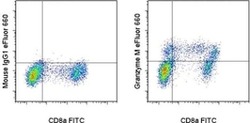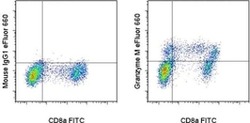Antibody data
- Antibody Data
- Antigen structure
- References [6]
- Comments [0]
- Validations
- Flow cytometry [2]
Submit
Validation data
Reference
Comment
Report error
- Product number
- 50-9774-42 - Provider product page

- Provider
- Invitrogen Antibodies
- Product name
- Granzyme M Monoclonal Antibody (4B2G4), eFluor™ 660, eBioscience™
- Antibody type
- Monoclonal
- Antigen
- Other
- Description
- Description: Granzyme M is one of five granzyme serine proteases that have been identified in humans. These proteins are expressed in the granules of NK cells and cytotoxic T cells, and are critical for the induction of target cell apoptosis through the cleavage of intracellular substrates. Although not as well characterized as some of the other family members, Granzyme M has been found to exhibit some distinct functions. These include the non-cytotoxic inhibition of cytomegalovirus replication, induction of apoptosis in tumor cells, and contribution to the TLR4-induced inflammatory process. Applications Reported: This 4B2G4 antibody has been reported for use in intracellular staining followed by flow cytometric analysis. Applications Tested: This 4B2G4 antibody has been pre-titrated and tested by intracellular staining followed by flow cytometric analysis of normal human peripheral blood cells using the Intracellular Fixation & Permeabilization Buffer Set (Product # 88-8824-00) and protocol. Please refer to BestProtocols®: Protocol A: Two step protocol for (cytoplasmic) intracellular proteins located under the Resources Tab online. This can be used at 5 µL (0.125 µg) per test. A test is defined as the amount (µg) of antibody that will stain a cell sample in a final volume of 100 µL. Cell number should be determined empirically but can range from 10^5 to 10^8 cells/test. eFluor® 660 is a replacement for Alexa Fluor® 647. eFluor® 660 emits at 659 nm and is excited with the red laser (633 nm). Please make sure that your instrument is capable of detecting this fluorochrome. Excitation: 633-647 nm; Emission: 668 nm; Laser: Red Laser. Filtration: 0.2 µm post-manufacturing filtered.
- Reactivity
- Human
- Host
- Mouse
- Isotype
- IgG
- Antibody clone number
- 4B2G4
- Vial size
- 100 Tests
- Concentration
- 5 μL/Test
- Storage
- 4°C, store in dark, DO NOT FREEZE!
Submitted references CD8(+) T cells specific for an immunodominant SARS-CoV-2 nucleocapsid epitope display high naive precursor frequency and TCR promiscuity.
Human γδ T-cell receptor repertoire is shaped by influenza viruses, age and tissue compartmentalisation.
Resistance of HIV-infected macrophages to CD8(+) T lymphocyte-mediated killing drives activation of the immune system.
Granzyme M targets host cell hnRNP K that is essential for human cytomegalovirus replication.
Human and mouse granzyme M display divergent and species-specific substrate specificities.
A role for granzyme M in TLR4-driven inflammation and endotoxicosis.
Nguyen THO, Rowntree LC, Petersen J, Chua BY, Hensen L, Kedzierski L, van de Sandt CE, Chaurasia P, Tan HX, Habel JR, Zhang W, Allen LF, Earnest L, Mak KY, Juno JA, Wragg K, Mordant FL, Amanat F, Krammer F, Mifsud NA, Doolan DL, Flanagan KL, Sonda S, Kaur J, Wakim LM, Westall GP, James F, Mouhtouris E, Gordon CL, Holmes NE, Smibert OC, Trubiano JA, Cheng AC, Harcourt P, Clifton P, Crawford JC, Thomas PG, Wheatley AK, Kent SJ, Rossjohn J, Torresi J, Kedzierska K
Immunity 2021 May 11;54(5):1066-1082.e5
Immunity 2021 May 11;54(5):1066-1082.e5
Human γδ T-cell receptor repertoire is shaped by influenza viruses, age and tissue compartmentalisation.
Sant S, Jenkins MR, Dash P, Watson KA, Wang Z, Pizzolla A, Koutsakos M, Nguyen TH, Lappas M, Crowe J, Loudovaris T, Mannering SI, Westall GP, Kotsimbos TC, Cheng AC, Wakim L, Doherty PC, Thomas PG, Loh L, Kedzierska K
Clinical & translational immunology 2019;8(9):e1079
Clinical & translational immunology 2019;8(9):e1079
Resistance of HIV-infected macrophages to CD8(+) T lymphocyte-mediated killing drives activation of the immune system.
Clayton KL, Collins DR, Lengieza J, Ghebremichael M, Dotiwala F, Lieberman J, Walker BD
Nature immunology 2018 May;19(5):475-486
Nature immunology 2018 May;19(5):475-486
Granzyme M targets host cell hnRNP K that is essential for human cytomegalovirus replication.
van Domselaar R, de Poot SA, Remmerswaal EB, Lai KW, ten Berge IJ, Bovenschen N
Cell death and differentiation 2013 Mar;20(3):419-29
Cell death and differentiation 2013 Mar;20(3):419-29
Human and mouse granzyme M display divergent and species-specific substrate specificities.
de Poot SA, Westgeest M, Hostetter DR, Van Damme P, Plasman K, Demeyer K, Broekhuizen R, Gevaert K, Craik CS, Bovenschen N
The Biochemical journal 2011 Aug 1;437(3):431-42
The Biochemical journal 2011 Aug 1;437(3):431-42
A role for granzyme M in TLR4-driven inflammation and endotoxicosis.
Anthony DA, Andrews DM, Chow M, Watt SV, House C, Akira S, Bird PI, Trapani JA, Smyth MJ
Journal of immunology (Baltimore, Md. : 1950) 2010 Aug 1;185(3):1794-803
Journal of immunology (Baltimore, Md. : 1950) 2010 Aug 1;185(3):1794-803
No comments: Submit comment
Supportive validation
- Submitted by
- Invitrogen Antibodies (provider)
- Main image

- Experimental details
- Normal human peripheral blood cells were stimulated for 3 days with Human IL-2 Recombinant Protein (Product # 14-8029-81), then cultured with Protein Transport Inhibitor Cocktail (Product # 00-4980-03) for an additional 5 hours. The cells were intracellularly stained with Anti-Human CD8 FITC (Product # 11-0087-42) and Mouse IgG1 Isotype Control eFluor® 660 (Product # 50-4714-82) (left) or Anti-Human Granzyme M eFluor® 660 (right) using the Intracellular Fixation and Permeabilization Buffer Set (Product # 88-8824-00) and protocol. Viable cells in the lymphocyte gate, as determined by Fixable Viability Dye eFluor® 450 (Product # 65-0863-14), were used for analysis.
- Submitted by
- Invitrogen Antibodies (provider)
- Main image

- Experimental details
- Normal human peripheral blood cells were stimulated for 3 days with Human IL-2 Recombinant Protein (Product # 14-8029-81), then cultured with Protein Transport Inhibitor Cocktail (Product # 00-4980-03) for an additional 5 hours. The cells were intracellularly stained with Anti-Human CD8 FITC (Product # 11-0087-42) and Mouse IgG1 Isotype Control eFluor® 660 (Product # 50-4714-82) (left) or Anti-Human Granzyme M eFluor® 660 (right) using the Intracellular Fixation and Permeabilization Buffer Set (Product # 88-8824-00) and protocol. Viable cells in the lymphocyte gate, as determined by Fixable Viability Dye eFluor® 450 (Product # 65-0863-14), were used for analysis.
 Explore
Explore Validate
Validate Learn
Learn Flow cytometry
Flow cytometry